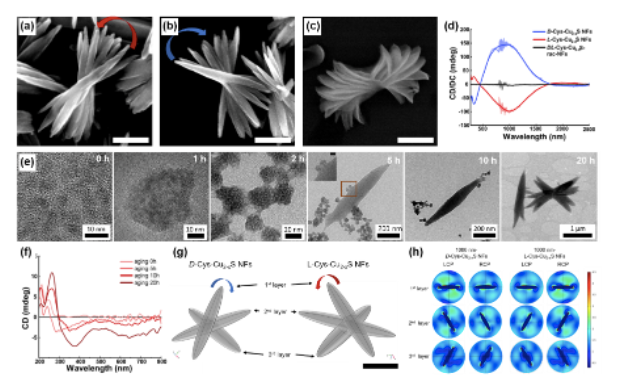
Professor Yeom’s research team (Department of Materials Science and Engineering, KAIST) developed chiral ceramic nanostructures with broad chiroptical activity through a self-assembly process. They controlled the attraction and repulsion forces with copper sulfide nanoparticles (NPs) coated with cysteine (Cys), which led to the formation of chiral nanoflowers (NFs) on a sub-micrometer scale. The synthesized NFs showed broad chiroptical activity from the ultraviolet (UV) to short-wave infrared (SWIR) region. The study was published in the September 14th issue of ACS Nano (Broad Chiroptical Activity from Ultraviolet to Short-Wave Infrared by Chirality Transfer from Molecular to Micrometer Scale, ACS Nano, 15, 9, 15229-15237 (2021)).
*Chiral: An object or a system is chiral if it is distinguishable from its mirror image; that is, it cannot be superimposed onto itself.
*Chiroptical activity: Materials that have differential absorption properties of left- and right-circularly polarized light inhibit chiroptical activity.
SWIR light can be utilized for the optical stimulation of neurons and in bio-imaging and tumor evaluation applications due to its high transparency when used with human skin. Taking advantage of the nontoxic, inexpensive and tunable properties of copper sulfide nanomaterials combined with SWIR chiroptical activity, synthesized NFs will allow the realization of applications in bio-imaging, photothermal therapy, and polarization bio-encryption. However, developing chiral nanostructures with chiroptical activity in the SWIR region was a challenge because the materials needed 1) sub-micrometer dimensions similar to the wavelength of SWIR light, 2) chiral structures, and 3) the ability to absorb SWIR light.
To address these limitations, professor Yeom’s team used 1) self-assembly by controlling the attraction and repulsion forces between copper sulfide NPs and 2) Cys, a chiral molecule, as a surfactant in NPs synthesis. With the self-assembly strategy, NPs assembled into NFs with dimensions of 1.5-2 um. During this process, the molecular chirality of Cys was transferred to the nanoscale chirality of NPs and then to the micrometer-scale chirality of NFs.
Furthermore, Yeom’s team found that the origin of the chiroptical activity was from the chiral geometry of the NFs by analyzing the phase transformation and through a computational simulation. Thus, this research provides a strategy to synthesize chiral nanomaterials with broad chiroptical activity by utilizing the self-assembly of NPs.
“We will work to expand the wavelength range of chiroptical activity to the short-wave infrared region, thus reshaping our everyday lives in the form of a bio-barcode that can store a vast amount of information under the skin,” said Professor Yeom.
This study was funded by the Ministry of Science and ICT, the Ministry of Health and Welfare, the Ministry of Food and Drug Safety, the National Research Foundation of Korea, the KAIST URP Program, the KAIST Creative Challenging Research Program, Samsung, and by the POSCO Science Fellowship.
Ki Hyun Park, Prof. Jihyeon Yeom Dept. of Materials Science and Engineering, KAIST
Homepage: http://yeom-lab.kaist.ac.kr
E-mail: jhyeom@kaist.ac.kr






